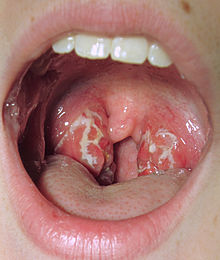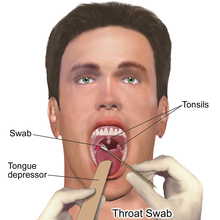Pharyngitis
| Pharyngitis | |
|---|---|
| Other names | Acute sore throat |
throat swab[2] | |
| Differential diagnosis | Epiglottitis, thyroiditis, retropharyngeal abscess[2] |
| Treatment | lidocaine[2][4] |
| Frequency | ~7.5% of people in any 3-month period[5] |
Pharyngitis is
Most cases are caused by a
About 7.5% of people have a sore throat in any 3-month period.[5] Two or three episodes in a year are not uncommon.[1] This resulted in 15 million physician visits in the United States in 2007.[4] Pharyngitis is the most common cause of a sore throat.[11] The word comes from the Greek word pharynx meaning "throat" and the suffix -itis meaning "inflammation".[12][13]
Classification

Pharyngitis is a type of inflammation caused by an
Clergyman's sore throat or clergyman's throat is an archaic term formerly used for chronic pharyngitis associated with overuse of the voice as in public speaking. It was sometimes called dysphonia clericorum or chronic folliculitis sore throat.[17]
Cause
Most cases are due to an
Viral
These comprise about 40–80% of all infectious cases and can be a feature of many different types of viral infections.[11][18]
- Adenovirus is the most common of the viral causes. Typically, the degree of neck lymph nodeenlargement is modest and the throat often does not appear red, although it is painful.
- The family Orthomyxoviridae which cause influenza are present with rapid onset high temperature, headache, and generalized ache. A sore throat may be associated.
- heterophile testcan be used if this is suspected.
- Herpes simplex virus can cause multiple mouth ulcers.
- Measles
- parainfluenza viruscan cause infection of the throat, ear, and lungs causing standard cold-like symptoms and often pain.
Bacterial
A number of different bacteria can infect the human throat. The most common is
Streptococcal pharyngitis

Streptococcal pharyngitis or strep throat is caused by a
Fusobacterium necrophorum
Diphtheria
Diphtheria is a potentially life-threatening upper respiratory infection caused by Corynebacterium diphtheriae, which has been largely eradicated in developed nations since the introduction of childhood vaccination programs, but is still reported in the Third World and increasingly in some areas in Eastern Europe. Antibiotics are effective in the early stages, but recovery is generally slow.[citation needed]
Others
A few other causes are rare, but possibly fatal, and include
Fungal
Some cases of pharyngitis are caused by
Noninfectious
Pharyngitis may also be caused by mechanical, chemical, or thermal irritation, for example cold air or
Diagnosis
| Points | Probability of Strep | Management |
|---|---|---|
| 1 or less | <10% | No antibiotic or culture needed |
| 2 | 11–17% | Antibiotic based on culture or rapid antigen detection test
|
| 3 | 28–35% | |
| 4 or 5 | 52% | Empiric antibiotics
|

Differentiating a viral and a bacterial cause of a sore throat based on symptoms alone is difficult.[29] Thus, a throat swab often is done to rule out a bacterial cause.[30]
The modified Centor criteria may be used to determine the management of people with pharyngitis. Based on five clinical criteria, it indicates the probability of a streptococcal infection.[21]
One point is given for each of the criteria:[21]
- Absence of a cough
- Swollen and tender cervical lymph nodes
- Temperature more than 38.0 °C (100.4 °F)
- Tonsillar exudate or swelling
- Age less than 15 (a point is subtracted if age is more than 44)
The
Management
The majority of the time, treatment is symptomatic. Specific treatments are effective for bacterial, fungal, and
Medications
- NSAIDs and acetaminophen (paracetamol), can help reduce the pain associated with a sore throat. Aspirin may be used in adults, but is not recommended in children due to the risk of Reye syndrome.[31]
- Steroids (such as dexamethasone) may be useful for severe pharyngitis.[32][10] Their general use, however, is poorly supported.[9]
- Viscous lidocaine relieves pain by numbing the mucous membranes.[33]
- Antibiotics are useful if a bacterial infection is the cause of the sore throat.[34][35] For viral infections, antibiotics have no effect. In the United States, they are used in 25% of people before a bacterial infection has been detected.[36]
- Oral analgesic solutions, the active ingredient is usually phenol, but also less commonly benzocaine, cetylpyridinium chloride, and/or menthol. Chloraseptic and Cepacol are two examples of brands of these kinds of analgesics.[citation needed]
Alternative
Gargling
Epidemiology
Acute pharyngitis is the most common cause of a sore throat and, together with cough, it is diagnosed in more than 1.9 million people a year in the United States.[11]
References
- ^ ISBN 9780729583459. Archivedfrom the original on 8 September 2017.
- ^ PMID 26276908.
- ^ ISBN 9780191631733. Archivedfrom the original on 10 October 2016.
- ^ PMID 24439883.
- ^ ISBN 9780198567820. Retrieved 4 August 2016.
- OCLC 908336985. Archived from the originalon 28 October 2021. Retrieved 17 March 2020.
- ^ "Pharyngitis". National Library of Medicine. Archived from the original on 20 May 2016. Retrieved 4 August 2016.
- ^ "Acute pharyngitis - Symptoms, diagnosis and treatment | BMJ Best Practice". bestpractice.bmj.com.
- ^ PMID 22993127.
- ^ PMID 32356360.
- ^ ISBN 978-0-323-05472-0.
- ISBN 978-0323078665. Archivedfrom the original on 8 September 2017.
- ISBN 9781111780500. Archivedfrom the original on 8 September 2017.
- ^ "Tonsillitis". Archived from the original on 25 March 2016. Retrieved 4 August 2016.
- PMID 16574523.
- ^ "www.nlm.nih.gov". Archived from the original on 17 November 2015.
- S2CID 239663449.
- ^ Acerra JR. "Pharyngitis". eMedicine. Archived from the original on 17 March 2010. Retrieved 28 April 2010.
- ^ PMID 11172144.
- S2CID 13141765.
- ^ from the original on 8 February 2015.
- S2CID 207535809.
- ^ "UpToDate Inc". Archived from the original on 27 June 2009. (registration required)
- S2CID 9009912.
- PMID 12688577.
- ^ Harvard Medical School. "Sore Throat (Pharyngitis)". Harvard Health Publishing Harvard Medical School. Harvard Health Publishing. Retrieved 3 December 2019.
- ^ "Mirapex product insert" (PDF). Boehringer Ingelheim. 2009. Archived (PDF) from the original on 14 June 2010. Retrieved 30 June 2010.
- ^ "Mosby's Medical Dictionary, 8th edition". Elsevier. 2009. Retrieved 30 June 2010.
- ^ PMID 22965026.
- PMID 1565052.
- S2CID 13141765.
- PMID 19661138.
- ^ "LIDOCAINE VISCOUS (Xylocaine Viscous) side effects, medical uses, and drug interactions". Archived from the original on 8 April 2010.
- PMID 25077497.
- PMID 34881426.
- S2CID 24465793.
- ^ a b "Sore throat: Self-care". Mayo Clinic. Archived from the original on 29 September 2007. Retrieved 17 September 2007.
External links
